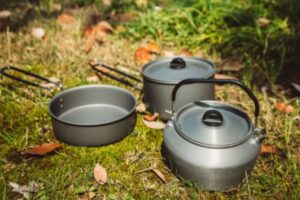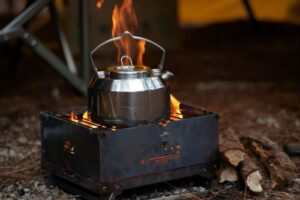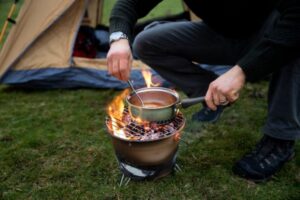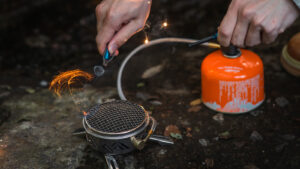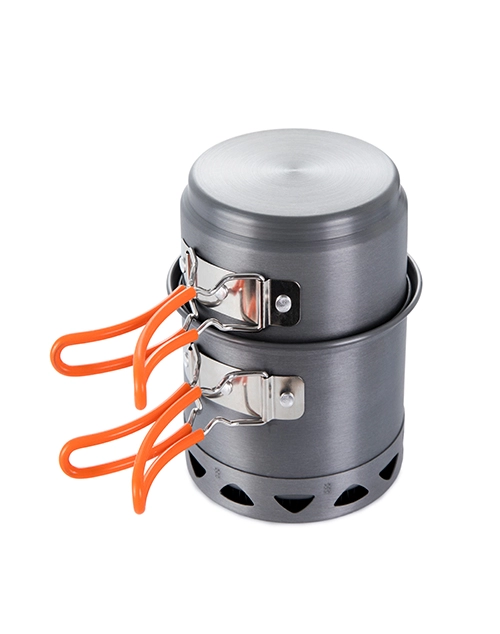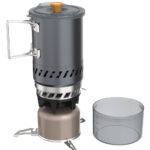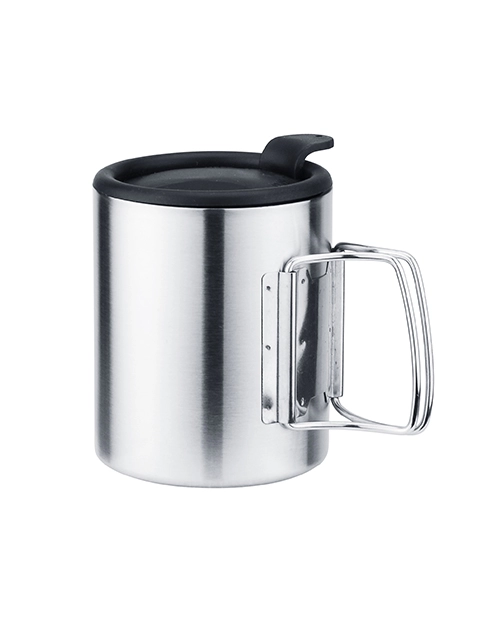Titanium Cookware for Backpacking: Pros & Cons
Share:

If you’re going backpacking, this article has everything you need to know about titanium cookware. It includes important things you should know about their cons.
The Big Four of Cookware
The cooking gear you bring with you on a camping trip can make or break the trip. For instance, if you like to hike, cast iron will be too heavy for you to take. Others, like metal, have hot spots that can make it hard to cook everything evenly. So, you should always find out for yourself which types of tools work best for you.
Thankfully, there are only four main types from which to choose:
- Titanium
- Aluminum
- Stainless Steel
- Cast Iron
Based on the material they are made of, each food pot has its own pros and cons. Putting these four things on a scale is a simple way to look at it.
Cast iron is very different from titanium because it is heavy, heats up slowly, and spreads heat out evenly. It can be heavy, though, so it can be hard to take long distances. Ti, on the other hand, isn’t as heavy, but it has hot spots, so if you want to use a rocket stove, you’ll need to cook slowly.
However, titanium is still a great material for cooking. Let’s uncover the reason.
Why Titanium?
The main reason to bring titanium pots on a camping trip is that they are lighter. Titanium is a metal that is already pretty light, and because it is strong for its weight, less of it can be used without lowering its sturdiness too much.
The Toaks Titanium 1100 ml, which has the same volume (1.1 liters) as the GSI Outdoors Halulite Boiler but is made of hard-anodized aluminum, weighs only 5.6 oz. Gram counters will notice that the metal pot is 1.5 times heavier, but most people won’t mind the extra 3 oz.
Since titanium is a very light metal, most pots made of it have thin walls that let heat move quickly. It’s not great for cooking (see below), but it’s great for boiling water. Titanium doesn’t rust, will not give your food a metallic taste, and isn’t usually used with non-stick coats.
Pros of Titanium
Titanium is Lightweight
Titanium is one of the lightest materials you can use to make dishes, and it may be our favorite material for long trips. For example, cast iron is great for cooking outside, but it’s not made to be used for hikes.
Titanium Gets Hot Quickly
Titanium gets hot very quickly, so you can start cooking right away. Additionally, things that heat up faster use less fuel, so you use less resources while cooking.
Titanium is Strong Material
Titanium doesn’t react with food like acidic or alkaline things do because it is very stable. Because its qualities don’t change when it’s heated up, this type of cookware is generally safer.
Cons of Titanium
More Expensive than other Cookware
The high demand for titanium makes cookware cost more than stainless steel or aluminum. Titaniumware will cost more than other types of pan because it is strong, light, and doesn’t leach into food.
Titanium Does not Spread Heat Out Evenly
Titanium heats up wherever the spark is. It is known for having “hot spots.” Making this mistake could cause your food to not cook properly, so keep an eye on it and move it around a lot. For best results, cook on low heat and add butter or oil.
Titanium Cools Down Quickly
It depends on how you look at it, this could be a pro or a con. For instance, you’ll have to start over if your fire goes out and you want to cook more food. On top of that, the fact that it cools down quickly is helpful if you need to cook quickly.
Titanium vs. Aluminum
Many people also like to use hard-anodized metal for their backpacking cookware. It’s heavier than titanium, costs less, and, most importantly, it moves heat to your food more quickly and evenly. A few extra ounces are probably worth it if you like to cook “real food” in the woods instead of just boiling water.
Titanium vs. Stainless Steel
Stainless steel is heavier than both titanium and aluminum, and it has the same tendency as titanium to get hot spots that burn food. The best thing about it is how long it lasts. It will look brand new for a much longer time than other materials and will last forever.
What Size Pot?
The size is the most important thing to consider when choosing a titanium pot. Pot sizes are shown by how many liters or milliliters of water they can hold. If it’s too small, you won’t be able to fit all of your food (if you’re actually cooking) or you’ll have to boil water twice to make your whole meal. When it’s too big, it adds weight and bulk that you don’t need.
The smallest pots for solo camping hold about 500 ml (0.5 liters), which is about the size of a mug. These can work for fast-and-light hikers who are going it alone and eating frozen meals straight from the pot. A few more liters, or 0.75 or 0.8 liters, is what many solo campers like, so they have extra water for a hot drink or washing dishes. When you cook in your pot instead of just boiling water, it’s better to be on the bigger side.
If you’re cooking for a lot of people, look at pots that are 1.5 liters or bigger. As a rule, fast-and-light people like titanium, so it’s not common to find pots in this range. However, there are a few. One of the largest titanium camping pots is the MSR Big Titan Kettle, which holds 2 liters.
Now that you know the good and bad things about titanium, you can decide if you want to buy titanium backpack cooking set. Most of the time, titanium-based cookware will make any outdoor trip easier if you plan to cook for yourself and move around a lot.
ODM service
Looking for reliable titanium cookware wholesale? At Deermaple, we specialize in ODM service, offering high-quality, innovative outdoor gear tailored to your needs.
If you are interested, please contact us.
Disclaimer: This blog may contain user comments, opinions, and other user-generated content. We are not responsible for the accuracy, reliability, or opinions of user-generated content. User-generated content represents the opinions of the individual authors only and does not reflect the views of this website.
clarachen
Related Posts
Related Products
No products found.

